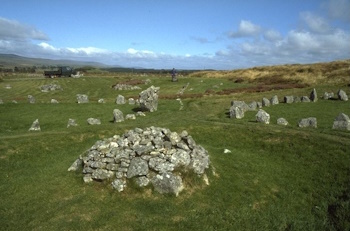Virtual Walkabouts
Clive Ruggles, 2003. https://doi.org/10.5284/1000185. How to cite using this DOI
Data copyright © Prof Clive Ruggles unless otherwise stated
This work is licensed under the ADS Terms of Use and Access.

Primary contact
Prof
Clive
Ruggles
School of Archaeological Studies
University of Leicester
School of Archaeology and Ancient History
University Road
Leicester
LE1 7RH
Tel: 0116 2523409
Fax: 0116 2525005
Resource identifiers
- ADS Collection: 332
- DOI:https://doi.org/10.5284/1000185
- How to cite using this DOI
Introduction

What is a Virtual Walkabout?
The "Virtual Walkabout" archives contain a series of still, 2-dimensional photographic images that collectively try to express the experience of walking round an archaeological site or monument. The images are presented in their Virtual order from a given point of departure, and are connected by a series of moves, forwards, backwards, pan left, pan right, step left or step right. The user of a walkabout archive can replicate walking around an archaeological landscape: walking up an avenue, around a carved stone or from one site to another. In this way it is possible to use simple 2 dimensional images to imitate the experience of visiting an archaeological site.
Though based on a site, monument or landscape, the walkabout could also be used to express any series of relationships between images that exist on a single 2 dimensional plane, such as might be taken of buildings, artefacts or artwork.
Each walkabout consists of 3 sets of images at different resolutions: a small "thumbnail" image, a medium sized view and a full sized master copy.
In addition, the Virtual Walkabout includes a generator tool which can be used to generate walkabouts from any archaeological site, provided the images are arranged, processed and indexed as appropriate. The Walkabout Generator is supported by a short tutorial which is intended to encourage students to undertake their own simple fieldwork project and presents many of the common problems that fieldworkers face but which students often overlook.
Lecturers and tutors are invited to use the walkabout to prepare students for field work. Students and those using the walkabout are encouraged to submit their own "Virtual Walkabouts" for possible archiving with the ADS.
The Virtual Walkabout derives from an original idea of Prof Clive Ruggles who provided the initial set of images from the sites of Beaghmore and Avebury. The tools and tutorial presented here were devised by Dr Michael Reynier of the Learning and Teaching Support Network Centre for History, Classics and Archaeology. Technical support and design was provided by Jo Clarke of the ADS.





